Airmodel 1/72 F8U-3 Super Crusader
|
KIT #: |
AM060 |
|
PRICE: |
11.00 Euros |
|
DECALS: |
None supplied |
|
REVIEWER: |
Carmel J. Attard |
|
NOTES: |
Vacuform kit with injected
plastic parts |

The Vought F8U-3 Super
Crusader was a re-engined version of the Crusader that has been in service with
the
US
Navy. It was a time when a need was felt for the acquisition of all-weather
defence aircraft for American aircraft carriers in the 60s. Three prototypes
were built of this interesting and highly sophisticated aircraft. Two companies,
Chance Vought and McDonnell had been working on two separate private
developments for the Navy. Vought redesigned the successful Crusader utilising
much of Crusader derived experience while McDonnell with experience in military
aviation with types that saw combat in Korea came with a new design, the twin
engined F4H-1 Phantom II.
The
Crusader
III
as it came to be known was an extremely advanced aircraft but its possibilities
were stillborn when the Phantom eventually won the competition. Vought’s
development contract was cancelled in December 1958. The Phantom went on to
become one of the greatest aircraft in military aviation. The XF8U-3 offered
tremendous potential and performance that only few appreciated at the time. The
first prototype Bu No 146340 was powered by a Pratt and Whitney J75 Turbojet
with afterburner
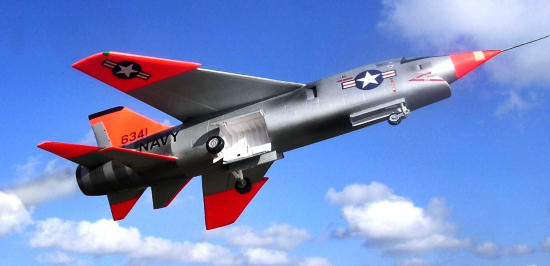 producing
29,000Lb of thrust. The second Bu No 146341 and third Bu No 146085 used engines
that supplied 23,500 lb of thrust, but which offered also water injection for
longer periods at high speed. The new Vought fighter also flew without internal
guns but carried two types of air-to-air missiles, the
AIM-7
Sparrow and the shorter-range
AIM-9
Sidewinder. Both were used extensively in
Vietnam
and beyond. Weapons avionics and nose mounted radar were state-of-the-art
produced by Raytheon of
New England
and Autotechnics a subsidiary of North American Aviation,
California.
A Head Up Display that went earlier tests on F3D Skyknight was also installed.
producing
29,000Lb of thrust. The second Bu No 146341 and third Bu No 146085 used engines
that supplied 23,500 lb of thrust, but which offered also water injection for
longer periods at high speed. The new Vought fighter also flew without internal
guns but carried two types of air-to-air missiles, the
AIM-7
Sparrow and the shorter-range
AIM-9
Sidewinder. Both were used extensively in
Vietnam
and beyond. Weapons avionics and nose mounted radar were state-of-the-art
produced by Raytheon of
New England
and Autotechnics a subsidiary of North American Aviation,
California.
A Head Up Display that went earlier tests on F3D Skyknight was also installed.
Test
pilot John Konrad flew the first flight of XF8U-3 having also undertaken the
maiden flight of XF8U-1 three years earlier and who would make the first flight
in September of the YA-7A Corsair. Konrad has flown P-47 and B-17 in
Europe
during WWII. Konrad who joined Vought in 1953 stayed with the
Dallas
based company until he retired in 1990. The multi shock air intake was
particularly suited to high supersonic speed and with the J75 engine being the
most powerful engine at the time in the
USA
was as envisaged for increased high-level performance. The armament consisted
entirely of missiles, namely the Sparrows half sunk into the fuselage. It had a
variable incidence wing to improve visibility for deck landings. A boundary
layer control system of the flap-blowing type was to increase the lift
coefficient during critical phases of take-off and landing. Aircraft stability
at high speed was attained with two fins beneath the rear part of the fuselage.
These folded horizontally during take off and landing.
The first flight
of the type was
12th
June 1958,
shortly after that however the aircraft was relegated to carrying out research
on high-speed flight for NASA. The three Vought test pilots still found it the
most impressive airplane they have ever seen. Some interesting fact told years
later like highest mach number achieved during the course of the Edwards AFB,
the F8U-3 flight test program was mach 2.39 equivalent to 1,6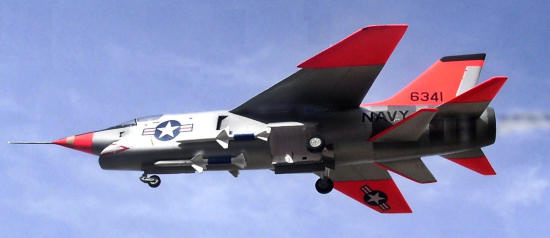 01
mph and at this speed the aircraft was still accelerating and it is believed
that it was the wind screen heat limitations that kept the airplane from flying
faster. The plexi glass simply could not take it especially for a long period of
time and therefore the Crusader never flew to its limits. Two
Langley
F8U-3 prototypes were barged to
Norfolk
NAS, Virginia for disposal and the spare airframe was moved to Penn Naval Air
Station for use as fire fighting target. The Crusader
III
remained to be proved till the end as the most delightful aeroplane to fly and
have ever seen by Admiral Engen. It was compared to the FJ3 Fury, which had
control harmony, and forces that made it one of the airplanes in the Navy
inventory. The overriding factors in the F4selection over the
III
were the avionics and automation of the control system as well as the twin-engined,
two-crew concept. Had the
III
gone into production it would have been the world’s fastest jet at the time.
01
mph and at this speed the aircraft was still accelerating and it is believed
that it was the wind screen heat limitations that kept the airplane from flying
faster. The plexi glass simply could not take it especially for a long period of
time and therefore the Crusader never flew to its limits. Two
Langley
F8U-3 prototypes were barged to
Norfolk
NAS, Virginia for disposal and the spare airframe was moved to Penn Naval Air
Station for use as fire fighting target. The Crusader
III
remained to be proved till the end as the most delightful aeroplane to fly and
have ever seen by Admiral Engen. It was compared to the FJ3 Fury, which had
control harmony, and forces that made it one of the airplanes in the Navy
inventory. The overriding factors in the F4selection over the
III
were the avionics and automation of the control system as well as the twin-engined,
two-crew concept. Had the
III
gone into production it would have been the world’s fastest jet at the time.
It is reckoned that had the Crusader
III
been produced in numbers, it would have been the fleet’s primary interceptor and
dogfighter during the Vietnam War. All reports told of the aircraft’s
acceleration, manoeuvrability and high-speed stability: prime requisites in
air-to-air combat. Speculating on combat engagements between N Vietnamese Migs
and the
III,
John Konrad believes that the highly manoeuvrable
III
“would have eaten them up”.
The aircraft excellent control harmony –noted by every
former test pilot-imparted an ease of handling that was alien to the stodgy F-4,
which Don Engen declared “flew like a truck” At the start of an aerial
engagement, the F-4 pilot usually had to unload and use his aircraft’s superior
power to escape from the lithe
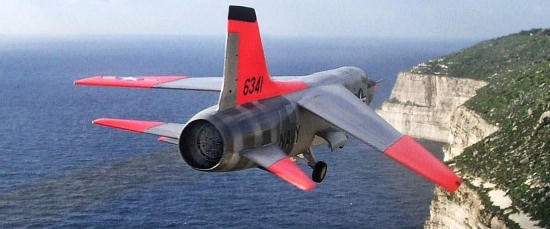 Mig-21.
Former F-8 pilot and retired Rear Admiral Paul Gillcrist later wrote when he
referred to the Crusader
III
brief history” the brightest moment of US Naval Aviation occurred like a
lightning flash, then died somewhat ignominiously”.
Mig-21.
Former F-8 pilot and retired Rear Admiral Paul Gillcrist later wrote when he
referred to the Crusader
III
brief history” the brightest moment of US Naval Aviation occurred like a
lightning flash, then died somewhat ignominiously”.
Note:
RADM Paul T Gillcrist is winner of seventeen combat
decorations for his duels with MiGs and SAMs in the bloody air war over
North Vietnam,
and making daring, dangerous ejections more than once in his heroic career.
Gillcrist speaks with authority as a former fighter squadron commanding officer
who recorded 167 combat missions over
Vietnam
flying the F-8 Crusader. Subsequently, he commanded a carrier air wing and
finally served, with the rank of Rear Admiral, as the wing commander for all
Pacific Fleet fighter squadrons. His pilot's logbook includes over 6,000 hours,
in seventy-one different types of aircraft from 1952 to 1981. He retired in 1985
as Assistant Deputy Chief of Naval Operations.
(Naturally, as an ex F-8 pilot, he is not biased. Just to
put things into perspective, Gilcrest's two ejections were due to F-8 engine
failures. One of the main reasons the Phantom was chosen over this aircraft was
due to the second engine, something that Naval fighters have had ever since.
Ed)
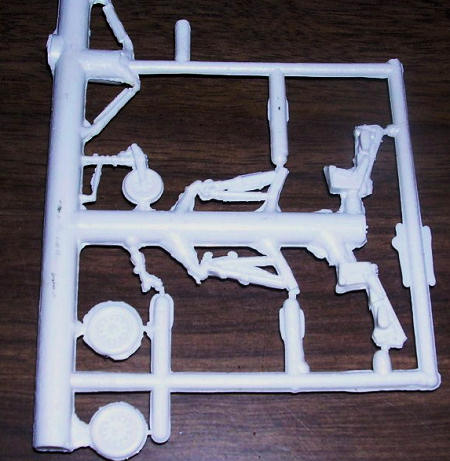 The
Vought F8U3 Crusader though belonging to an era that has received much attention
has received very little from model manufacturers. While the predecessor F8U-2
has been relatively well represented in the injection molded form by Heller,
Revell,
ESCI
and Hasegawa the Super Crusader F8U-3 until recently
(as in Anigrand resin)
was only issued in vac
form. Thanks to Airmodel of Germany who has it among the list of vac form kits.
This is a well reproduction of what could have been the super interceptor at the
time when it first flew. The F8U-3 differed quite considerably from the F8U-2
Crusader which was the best fighter in the Viet Nam war. It featured a notably
lengthened fuselage, a redesigned tail fin and having a most unusual feature
with its ‘sugar scoop’ air intake. Which had the advantage of providing air at
speeds approaching Mach 3. It also had bulkier fuselage to house the larger
diameter and more powerful P&W J-79 jet engine. The Crusader
III
had additional set of fuselage side fins to increase stability of the aircraft
at high-speed flight. The cockpit office was more spacious resulting into a
larger canopy. Three Crusader prototypes were built. The kit can be built into
any one of them the basic difference was that in one of them there was the broad
chord fin and with or without the air scoop. The kit comes in a white soft
styrene sheet containing all the kit major parts and a cockpit canopy in clear
acetate all being vac-formed. The kit itself is of moderate complexity as it
comes with injected landing gear and ejector seat. These are most welcome
features, which are normally absent in Airmodel kits I have built.
The
Vought F8U3 Crusader though belonging to an era that has received much attention
has received very little from model manufacturers. While the predecessor F8U-2
has been relatively well represented in the injection molded form by Heller,
Revell,
ESCI
and Hasegawa the Super Crusader F8U-3 until recently
(as in Anigrand resin)
was only issued in vac
form. Thanks to Airmodel of Germany who has it among the list of vac form kits.
This is a well reproduction of what could have been the super interceptor at the
time when it first flew. The F8U-3 differed quite considerably from the F8U-2
Crusader which was the best fighter in the Viet Nam war. It featured a notably
lengthened fuselage, a redesigned tail fin and having a most unusual feature
with its ‘sugar scoop’ air intake. Which had the advantage of providing air at
speeds approaching Mach 3. It also had bulkier fuselage to house the larger
diameter and more powerful P&W J-79 jet engine. The Crusader
III
had additional set of fuselage side fins to increase stability of the aircraft
at high-speed flight. The cockpit office was more spacious resulting into a
larger canopy. Three Crusader prototypes were built. The kit can be built into
any one of them the basic difference was that in one of them there was the broad
chord fin and with or without the air scoop. The kit comes in a white soft
styrene sheet containing all the kit major parts and a cockpit canopy in clear
acetate all being vac-formed. The kit itself is of moderate complexity as it
comes with injected landing gear and ejector seat. These are most welcome
features, which are normally absent in Airmodel kits I have built.
Kit parts also
have beautifully executed surface detail accurately reproduced. This can be
enhanced with the edge of a blunt blade if so desired.
The
components mainly the fuselage halves, wings, tail planes, different tail fins,
fuselage fins and cockpit bulkheads were separated from vac form backing sheet
in the time borrowed fashion, scribing around the components with a sharp knife
and separating them from the backing sheet by twisting and tearing action. Great
care was taken however around the pointed nose not to break off the nose tip.
The next operation was rubbing down starting with the fuselage. For smaller
items as tail fin pieces and stabilisers I used masking tape as a finger hold.
Trailing edges were generally scraped down on the inside face until the required
thin edge is produced.
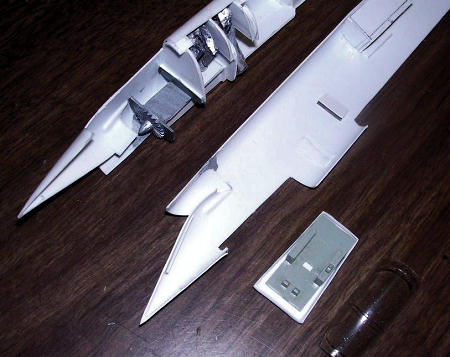 Cockpit
opening is cut into the fuselage, as also are the fuselage-side spill doors
downstream as used at lower speeds for air intake. The aft and forward bulkhead,
cockpit floor, side consoled and ejector seat are assembled to half of the
fuselage and painted in light grey and black instruments. A pilot figure also
added strapped to the seat as this will give indication of scale to the
aircraft. The nose and fuselage wheel wells are cut with a sharp knife and
detailed making reference to wells found on Crusader kits though slightly
smaller than the
III
version. A pocket for the nose weight was also built. Sea through effect of
intake was blanked with a spare engine front turbine detail. A cutaway drawing
in journal ‘Wings of fame. Vol 9’ provided position of this blanking piece
obtained from spares from surplus Tamiya Tomcat engine parts, which were
modified to suite. A rear engine part was also added further aft.. Plastic card
tabs ½” X ¼” were added to the fuselage joint line at intermittent spaces along
the length to serve as guides and secure the fuselage when glued. Wing halves
were also treated in normal manner avoiding excessive glue, which can result
into sink areas when set. Main wing halves also needed sprue length at mid
section of wings. These are of measured diameter identical to both wings on
either side.
Cockpit
opening is cut into the fuselage, as also are the fuselage-side spill doors
downstream as used at lower speeds for air intake. The aft and forward bulkhead,
cockpit floor, side consoled and ejector seat are assembled to half of the
fuselage and painted in light grey and black instruments. A pilot figure also
added strapped to the seat as this will give indication of scale to the
aircraft. The nose and fuselage wheel wells are cut with a sharp knife and
detailed making reference to wells found on Crusader kits though slightly
smaller than the
III
version. A pocket for the nose weight was also built. Sea through effect of
intake was blanked with a spare engine front turbine detail. A cutaway drawing
in journal ‘Wings of fame. Vol 9’ provided position of this blanking piece
obtained from spares from surplus Tamiya Tomcat engine parts, which were
modified to suite. A rear engine part was also added further aft.. Plastic card
tabs ½” X ¼” were added to the fuselage joint line at intermittent spaces along
the length to serve as guides and secure the fuselage when glued. Wing halves
were also treated in normal manner avoiding excessive glue, which can result
into sink areas when set. Main wing halves also needed sprue length at mid
section of wings. These are of measured diameter identical to both wings on
either side.
With
the fuselage halves glued and well secured it was turn to fix the wings in
place. The scale plans provided were referred to when fitting the wings to the
fuselage. Tail planes were horizontal while main planes had anhedral
inclination. I found it best was to cut a cardboard template to check the
fuselage to wings angle at both fuselage sides for correctness. At this stage
all molding pips were removed. The intake lip comes in two halves, these were
assembled with correct aperture and added to the front of fuselage beneath the
nose area and correctly aligned with the axis of the fuselage. Wherever needed
filler was applied and
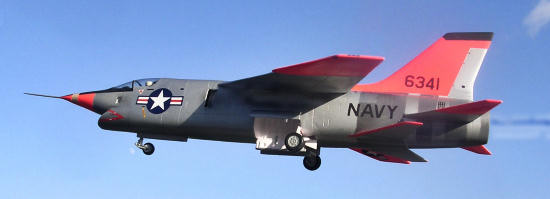 rubbed
down to a smooth surface. Any hidden surface detail was improved with a sharp
knife. I opted to fit the standard tail fin, the one that had no air intake at
its root. A long pointed metal needle was super glued to nose cone.
rubbed
down to a smooth surface. Any hidden surface detail was improved with a sharp
knife. I opted to fit the standard tail fin, the one that had no air intake at
its root. A long pointed metal needle was super glued to nose cone.
The
canopy was cut from its backing sheet with scissors and gently trimmed with a
new blade until a good fit was achieved. It was then glued to the fuselage with
a little Kristal Kleer and no filler was needed. Fuselage rear wheels were fixed
in place followed by nose wheel once the correct sit of the model was obtained
by adjusting the height of the nose wheel.
Any filler at seams was added at this stage followed by
sanding. Half cut Sparrow missiles were prepared. These were obtained from F4
kits Sparrows and were painted white and bright blue, three of them. These were
fixed in place after the first photo session.
I
decided to represent my model as the second prototype Bu No 6341. Apart from the
day glow areas the kit was airbrushed in an overall mix of silver and few drops
of gloss lacquer. Burnished areas were applied to rear of fuselage. Entire model
was given a coat of Klear. An assortment of Super Scale decal lettering and star
and bars were added to the kit and finally another coat of Klear sealed the
entire kit.
In
my opinion this is one of the best Airmodel kits ideal for attractive color
scheme to represent the prototype. I enjoyed this somewhat straightforward build
keeping in mind it is a vac form type. It is therefore recommended for anyone
who is new to building the type and kit is apparently still available from
www.airmodel.de
from where I got my model.
1)
Airmodel kit instructions
2)
Wings of Fame Vol 9
journal of classic combat aircraft.
3)
‘Feet wet’. Reflections of
a carrier pilot by Paul Gillcrist.
Carmel J. Attard
D
ecember
2011
Copyright ModelingMadness.com. All rights reserved. No reproduction in part or in whole without express permission.If you would like your product reviewed fairly and fairly quickly, please contact the editor or see other details in the
Note to
Contributors.
Back to the Main Page
Back to the Review
Index Page 2022


 producing
29,000Lb of thrust. The second Bu No 146341 and third Bu No 146085 used engines
that supplied 23,500 lb of thrust, but which offered also water injection for
longer periods at high speed. The new Vought fighter also flew without internal
guns but carried two types of air-to-air missiles, the
producing
29,000Lb of thrust. The second Bu No 146341 and third Bu No 146085 used engines
that supplied 23,500 lb of thrust, but which offered also water injection for
longer periods at high speed. The new Vought fighter also flew without internal
guns but carried two types of air-to-air missiles, the  01
mph and at this speed the aircraft was still accelerating and it is believed
that it was the wind screen heat limitations that kept the airplane from flying
faster. The plexi glass simply could not take it especially for a long period of
time and therefore the Crusader never flew to its limits. Two
01
mph and at this speed the aircraft was still accelerating and it is believed
that it was the wind screen heat limitations that kept the airplane from flying
faster. The plexi glass simply could not take it especially for a long period of
time and therefore the Crusader never flew to its limits. Two  Mig-21.
Former F-8 pilot and retired Rear Admiral Paul Gillcrist later wrote when he
referred to the Crusader
Mig-21.
Former F-8 pilot and retired Rear Admiral Paul Gillcrist later wrote when he
referred to the Crusader  The
Vought F8U3 Crusader though belonging to an era that has received much attention
has received very little from model manufacturers. While the predecessor F8U-2
has been relatively well represented in the injection molded form by Heller,
Revell,
The
Vought F8U3 Crusader though belonging to an era that has received much attention
has received very little from model manufacturers. While the predecessor F8U-2
has been relatively well represented in the injection molded form by Heller,
Revell, 
 rubbed
down to a smooth surface. Any hidden surface detail was improved with a sharp
knife. I opted to fit the standard tail fin, the one that had no air intake at
its root. A long pointed metal needle was super glued to nose cone.
rubbed
down to a smooth surface. Any hidden surface detail was improved with a sharp
knife. I opted to fit the standard tail fin, the one that had no air intake at
its root. A long pointed metal needle was super glued to nose cone.